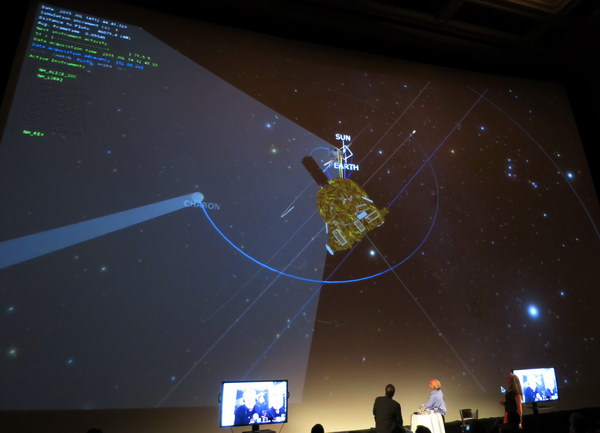As anyone with any connection to the Internet knows (i.e. all DD readers), the New Horizons spacecraft made its closest approach to dwarf planet Pluto at 7:50AM EDT (11:50 Universal Time, as used by astronomers) on July 14th.

The American Museum of Natural History (AMNH) carried it live on its giant IMAX screen and I was there, along with about 300 other members of the press and public.
 The 87’ (26.5M) diameter Hayden Planetarium is at the heart of the Rose Center for Earth and Space at the American Museum of Natural History in New York
The 87’ (26.5M) diameter Hayden Planetarium is at the heart of the Rose Center for Earth and Space at the American Museum of Natural History in New York
Live is a relative term, however. With a 4½ hour speed of light delay, it would not have been possible to view it with less of a delay than that. Second, New Horizons was too busy taking data to beam it back to earth. In fact, the data taken during the brief encounter with Pluto and its moon Charon will be beamed back to Earth over the next 16 months. One of the planetary scientists discussing the encounter with Pluto said one goal of a planetary scientist is to finish his experiment before he died – New Horizons has been in flight since 2006 and in the planning stage for years before that.
In order to make the event meaningful, the Applied Physics Laboratory (APL) at Johns Hopkins University showed a real time simulation showing the simulated events simultaneously with the real events that were happening 3 billion miles (4.8 billion KM) away. Of course, “simultaneous” doesn’t mean much when dealing with events where Special and General Relatively both apply, but never mind that. The simulation showed the motions of the New Horizons space craft; Pluto; Charon, Pluto’s largest moon; Pluto’s minor moons; the Earth; the Sun and the background stars all in real time. The motions of New Horizons included not just its motion through the Pluto system, but also the tilts and rolls that were used to point the various instruments and cameras on the spacecraft at their targets. The simulation also showed the boundaries of photos on Pluto and Charon as they were scheduled to be taken. You could see the successive images appear on the planet in a row as the spacecraft rolled to scan its camera. Not the images themselves, of course, but the boundaries of the planned images.
While the events being shown were predetermined, the viewpoint of the simulation observer could be changed as desired. My favorite viewpoint was from just behind the New Horizons spacecraft, showing not only the spacecraft but the Pluto system in the background.
 New Horizon spacecraft with Pluto, Earth and the Sun in the background. The spacecraft is just entering Pluto’s shadow, an event that will allow it to measure Pluto’s atmosphere. The data in the upper left corner of the simulation shows what is happening at any given instant, including which of the New Horizons instruments are active.
New Horizon spacecraft with Pluto, Earth and the Sun in the background. The spacecraft is just entering Pluto’s shadow, an event that will allow it to measure Pluto’s atmosphere. The data in the upper left corner of the simulation shows what is happening at any given instant, including which of the New Horizons instruments are active.
There are no motion bases on New Horizons, which is about the size of a grand piano. If you want to aim the camera, you had to aim the entire spacecraft. If you want to aim the camera at Pluto, the high-gain communications antenna wasn’t aimed at Earth.
New Horizons is powered by a plutonium fueled thermoelectric generator, which will generate about 200W of power, essentially forever. After passing Pluto, it is hoped that the spacecraft will continue to explore the Kuiper Belt, a largely unknown region of the solar system beyond the last planet, Neptune. At least one additional dwarf planet is known in the Kuiper Belt, Eris. Eris is almost the same diameter as Pluto but is significantly heavier, showing it has more rock and less ice. Scientists want to know “What’s going on here?”
The program at the AMNH was actually part of a world-wide linkage of planetariums, with about a dozen participating. This included planetariums in New Jersey, Chicago, Huston, Buenos Aries Singapore, Tokyo, Brisbane, Ghana (the first digital planetarium in sub-Sahara Africa), Italy and Germany. The simulation came from APL, in Maryland. While all planetariums could see the simulation live, along with the live commentary from the AMNH and the APL, live questions only came from Brisbane, Italy and Germany. Another one of the scientists described this event as a “Woodstock of Planetariums.”
How accurate was the simulation? That’s the big question and as I write this, nobody knows. New Horizons is scheduled to Phone Home on July 14th, with the signal arriving after its 4½ hour trip at 8:52 PM EDT (00:52 UT) and tell Earth if all went as planned. When you read this, the signal will have arrived so you can just check http://www.jhuapl.edu/pluto/ to see what happened. – Matthew Brennesholtz
p.s. At 8:55PM EDT July 14th (00:55 July 15th) NASA posted on Twitter “LOCKED! We have confirmation of a successful #PlutoFlyby”. So it wasn’t just a simulation after all.

